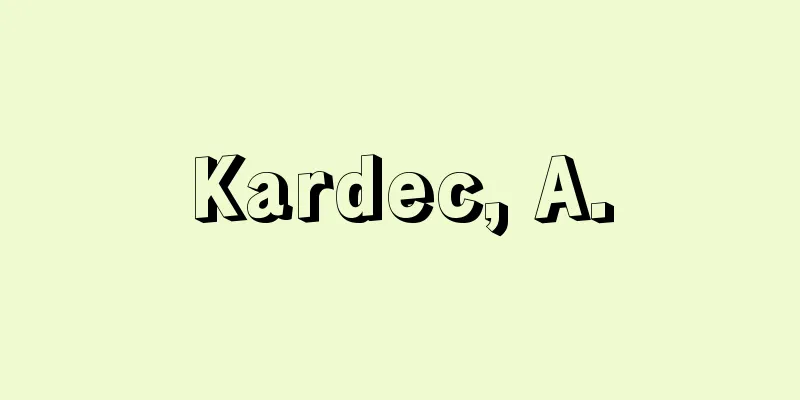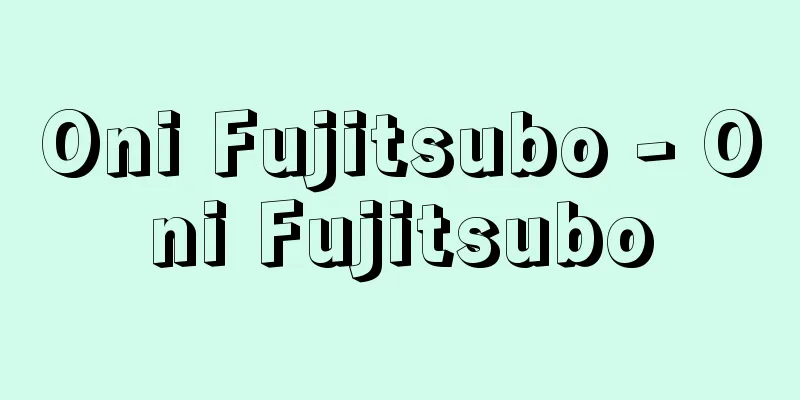Chocolate - chocolat (English spelling)

|
A confectionery and drink made from cacao beans. The word derives from the fact that the indigenous Mexicans called the drink made by crushing cacao beans chocolatl (meaning bitter water). The main ingredient of chocolate is cacao beans, which are roasted and ground into a paste, then kneaded with sugar and milk powder to make confectionery, while chocolate is made by dissolving it in water or milk. Historically, chocolate as a drink is older than chocolate as a confectionery. [Tomomi Kono and Yonago Yamaguchi] historyCacao trees are native to Central and South America, where the indigenous Mexicans called the beans a "gift from God" and used them as a drink, medicine, and currency. Columbus was the first to introduce them to Europe. He brought cacao beans back to Europe in 1502, but at the time, their uses and value were unknown and they did not become widespread. When Hernan Cortes of Spain conquered Mexico in 1519, he learned that people in Mexico called a drink made from cacao beans "chocolatl" and drank it to recover from fatigue and as a tonic. After he introduced it to Spain, the consumption of chocolate spread throughout Europe. In 1828, the Dutchman Coenraad Johannes Van Houten (1801-1887) removed some of the fat from cacao beans and created an easy-to-dissolve powdered chocolate drink (today's cocoa). Meanwhile, in the first half of the 17th century, the idea of solidifying chocolate was discovered, and confectionery making began. Solid plain chocolate was created as a confectionery in England in 1847, and milk chocolate was created in Switzerland in 1876. It is said that chocolate was first introduced to Japan as a drink by the Dutch in Nagasaki at the end of the 18th century. As a confectionery, it was sold by Fugetsudo in Tokyo in 1878 (Meiji 11) under the name "Zokoreito". Morinaga & Co. was the first to manufacture confectionery using cacao beans in earnest in 1918 (Taisho 7). The production volume of chocolate products in Japan increased from 28,000 tons in 1960 (Showa 35) to 110,000 tons in 1970, 127,000 tons in 1980, and 180,000 tons in 1990 (Heisei 2), and has remained stable at about 220,000 tons since 2000. Meanwhile, the import volume of chocolate products has also increased from about 5,000 tons in the 1970s to about 20,000 tons in the 2000s. [Tomomi Kono and Yonago Yamaguchi] Manufacturing method and typeTo make chocolate from cacao beans, the cacao seeds are first extracted from the cacao fruit (cacao pod). These are fermented and dried to become cacao beans. Selected cacao beans are roasted and crushed, the seed coat and germ are removed (cacao nibs), and the ground product is called cacao mass. This is cooled and solidified to become plain chocolate (also called bitter chocolate or baking chocolate for confectionery). Chocolate as it is generally known is made by adding sugar, milk powder, cocoa butter (the fat extracted from cacao mass, also called cocoa butter; the remaining powder is called cocoa powder), and refining it. Chocolate that contains milk powder is called milk chocolate, and chocolate that does not contain milk powder is called sweet chocolate (also called black chocolate). White chocolate is a white chocolate made by adding dairy products and sugar to cocoa butter. Chocolate types, based on their shape, include chocolate bars, shell chocolate (pouring into a mold to create a shell and filling inside), and coated chocolate (coating nuts, cakes, etc. with chocolate). [Tomomi Kono and Yonago Yamaguchi] standardThe quality of chocolate depends on the amount of cocoa beans, the blend, and the ingredients. Japan's fair competition code classifies chocolate into chocolate dough (35% or more cocoa content) and semi-chocolate dough (15% or more cocoa content). Products that are allowed to be labeled as "chocolate" are those that contain 60% or more chocolate dough, and "semi-chocolate" are those that contain 60% or more semi-chocolate dough. In addition, biscuits, cream, etc. covered in chocolate that contain less than 60% chocolate or semi-chocolate dough are required to be labeled as "chocolate confectionery" or "semi-chocolate confectionery". [Tomomi Kono and Yonago Yamaguchi] Ingredients and FlavorThe characteristic bitterness of chocolate is caused by a substance called theobromine, a weakly excitatory alkaloid. The smoothness of chocolate and how it melts in the mouth are determined by the amount of cocoa butter and the particle size adjustment during production. Cocoa butter normally melts at about 34°C, and has the characteristic of melting just inside the mouth. If chocolate is not stored at low temperatures, the cocoa butter will melt and a white powder will appear on the surface. This is called bloom, and it will impair the flavor, so care must be taken when storing it, especially in summer. Bloom can also occur when sugar melts and crystallizes. Chocolate is a high-energy food because it is high in fat and sugar. It has a long history of being used as a drink by the nobility in Europe, and has a strong image of being a high-class confectionery. In particular, the custom of putting it in a beautiful box and using it as a gift for Christmas or a party remains deeply rooted. In Japan, it is also customary for women to give chocolate to men on Valentine's Day. Chocolate for drinking is often made by dissolving confectionery chocolate in water or milk. [Tomomi Kono and Yonago Yamaguchi] "The Natural History of Chocolate" by Yukio Kato and Yoshiho Yasugi (1996, Shogakukan)" ▽ "The Book of Chocolate" edited by the Tea Time Books editorial department (1998, Shobunsha)" ▽ "The Story of Chocolate - How to Enjoy Chocolate the French Way" by Mika Ogura (2000, Tokyo Sogensha) ▽ "The Encyclopedia of Chocolate - Everything about Chocolate Loved Around the World" edited by the Seibidoshuppan editorial department (2003, Seibidoshuppan) [Reference items] | | | |©Shogakukan "> Chocolate manufacturing process Source: Shogakukan Encyclopedia Nipponica About Encyclopedia Nipponica Information | Legend |
|
カカオ豆を原料にした菓子および飲料。メキシコ先住民がカカオ豆をつぶしてどろどろにした飲料をチョコラトルchocolatl(苦い水の意)とよんでいたのが語源である。チョコレートの主原料はカカオ豆で、炒(い)ってペースト状に磨砕したものに砂糖や粉乳などを加えて練り上げたのが菓子、水や牛乳で溶かしたものが飲料のチョコレートである。歴史的には飲料としてのチョコレートのほうが菓子よりも古い。 [河野友美・山口米子] 歴史カカオの木の原産地は中南米で、メキシコ先住民はこの豆を「神からの賜物(たまもの)」とよび、飲み物や薬用として、また貨幣として利用していた。ヨーロッパに最初に伝えたのはコロンブスである。1502年にカカオ豆をヨーロッパに持ち帰ったが、その当時は、利用法や利用価値がわからず普及しなかった。1519年にメキシコを征服したスペインのエルナン・コルテスは、メキシコで人々がカカオ豆の飲料をチョコラトルとよび、飲んで疲労回復や強壮剤的に用いているのを知った。その後、彼がスペインへ飲料として紹介してから、ヨーロッパでチョコレートの飲用が広まった。1828年にオランダ人バン・ホーテンCoenraad Johannes Van Houten(1801―1887)はカカオ豆から脂肪を一部除き、とけやすい粉末チョコレートの飲み物(現在のココア)として完成させた。一方、17世紀前半には固形にすることが考案され、菓子作りが始まり、1847年にはイギリスで菓子として固形のプレーンチョコレートが、さらに1876年スイスでミルクチョコレートがつくられた。 日本では18世紀末にオランダ人が長崎に飲料として伝えたのが最初だといわれている。菓子としては、1878年(明治11)東京の凮月堂(ふうげつどう)から「貯古齢糖」の名で販売された。本格的にカカオ豆を原料として菓子を製造したのは1918年(大正7)森永製菓である。なお、日本におけるチョコレート製品の生産量は、1960年度(昭和35)の2万8000トンから、1970年には11万トンと増大し、1980年に12万7000トン、1990年(平成2)に18万トンとなり、2000年以降は約22万トンで横ばい状態となっている。一方、チョコレート製品の輸入量も1970年代の約5000トンから、2000年代の約2万トンへと増大している。 [河野友美・山口米子] 製法・種類カカオ豆からチョコレートにするには、まずカカオの種子をカカオの果実(カカオポッド)から取り出す。これを発酵し、乾燥したものがカカオ豆である。選別したカカオ豆を炒って破砕し、種皮と胚芽(はいが)を取り除き(カカオニブ)、すりつぶしたものをカカオマスという。これを冷却して固めたのがプレーンチョコレート(製菓用ではビターチョコレート、ベーキングチョコレートともいう)である。一般にいうチョコレートは、カカオマスに、砂糖、粉乳、ココアバター(カカオマスから取り出した脂肪分で、カカオバターともいう。残りの粉末はココアパウダーという)などを加え、精練したものである。粉乳を入れたものをミルクチョコレート、入れないものをスイートチョコレート(ブラックチョコレートともいう)という。ホワイトチョコレートは、ココアバターに乳製品や砂糖を加えた白色のものである。チョコレートの種類は、形状からは、板チョコレート、シェルチョコレート(型に流し込んで殻をつくり、中に詰め物をするもの)、被覆チョコレート(ナッツやケーキなどの上からチョコレートでカバーするもの)などがある。 [河野友美・山口米子] 規格チョコレートの品質は、カカオ豆の量、ブレンド、配合物などによって左右される。日本の公正競争規約では、チョコレート生地(カカオ分35%以上)、準チョコレート生地(カカオ分15%以上)に区分している。品名を「チョコレート」と表示できるのは、チョコレート生地が60%以上のもので、「準チョコレート」は準チョコレート生地が60%以上のものである。また、ビスケット、クリームなどをチョコレートで被覆したもので、チョコレート、準チョコレート生地がそれぞれ60%未満のものには、「チョコレート菓子」または「準チョコレート菓子」として表示することが義務づけられている。 [河野友美・山口米子] 成分・風味チョコレートに含まれる特有の苦味は、テオブロミンとよぶ物質で、弱い興奮性のアルカロイドである。チョコレートの滑らかさや、口中のとろけぐあいは、ココアバターの量や製造時の粒度調整によって決まる。ココアバターは普通約34℃で溶け、ちょうど口の中で溶ける特性をもっている。チョコレートは低温で保存しないと、ココアバターが溶け出し表面に白い粉がふいたようになる。これはブルームとよばれ、風味が損なわれるので、とくに夏の保存に注意を要する。ブルームは砂糖がとけて結晶化して生じる場合もある。チョコレートは脂肪や糖分が多いので、高エネルギー食品である。 ヨーロッパで貴族たちの飲料として用いた歴史が長いこともあり、高級な菓子のイメージが強い。とくに美しい箱に入れてクリスマスやパーティーのプレゼントに用いる習慣が根強く残っている。また、日本でのバレンタインデーには、女性から男性へチョコレートを贈る風習もある。 飲料としてのチョコレートは、製菓用のチョコレートを水や牛乳で溶かしたものが多い。 [河野友美・山口米子] 『加藤由基雄・八杉佳穂著『チョコレートの博物誌』(1996・小学館)』▽『ティータイム・ブックス編集部編『チョコレートの本』(1998・晶文社)』▽『小椋三嘉著『チョコレートものがたり――フランス流チョコレートの楽しみ方』(2000・東京創元社)』▽『成美堂出版編集部編『チョコレートの事典――世界中で愛されるチョコレートのすべて』(2003・成美堂出版)』 [参照項目] | | | |©Shogakukan"> チョコレートの製造工程 出典 小学館 日本大百科全書(ニッポニカ)日本大百科全書(ニッポニカ)について 情報 | 凡例 |
<<: Chaucer - Geoffrey Chaucer
>>: Chogorisa [Mountain] - Chogorisa
Recommend
Food preparation
...The placenta is delivered naturally within abo...
Multiculturalism - Tabunkashugi (English spelling) multiculturalism
An idea, movement, or policy that respects the cu...
Dogeza - Dogeza
〘Noun〙① When feudal lords or nobles pass by, ordin...
Scorpion - Scorpion
A general term for the Scorpionidae order of the A...
Free skating
… [Events and Competition Methods] The standard s...
Perfect image point cloud
...When viewed microscopically, there are 230 pos...
Nine-legged game
In Germany and the Netherlands, it is called Kegel...
Battlefield
〘 noun 〙 The place where a battle is held. Battlef...
"The Mysterious Tale of Katsura River Waves"
...He performed under the name of "Originato...
Pronounced
…It is often used synonymously with the Greek wor...
Freight car marshalling yard
…A type of railway station that does not handle p...
Genealogy - genealogy
A science that scientifically elucidates the authe...
Omi Silk Dispute
A human rights dispute over pre-modern labor manag...
Zingiberaceae
…In Chinese cuisine, it is often used in fish and...
Karabük (English spelling)
A city in Zonguldak Province in northwestern Turke...









